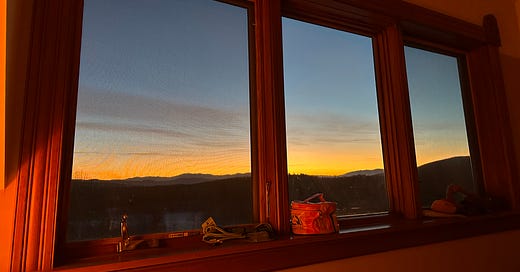It’s just at sub zero temperature here in Vermont. -3. These days with the crystal skies and the Maxfield Parrish colors at dawn and dusk. The deepest, back-lit blue to orange rainbow that makes up the whole sky. The pinhole stars. All the animals in the house use me as a heating pad. I fake complain but I like it. I’m so grateful that they love me. It’s too cold to walk Coco as it hurts her paws and my face.
This is the season of self-renewal and deep thinking, TV bingeing, stir craziness and experimental recipes. I don’t really care about Christmas (but I LOVE the tree) and I won’t get caught up in the buying. I fucking refuse. No, I’m not saying that makes me better than anyone else, just less stressed inside my own life and body. The noise is too much otherwise. I wake up so early and drink coffee. This is my favorite time of day; sunrise. I try to pinpoint where I am on the map of myself. I am on a trans-Siberian train journey inside my mind where I live in a tiny cabin for days at a time. The world does its own thing and I feel a little bit of relief. I am a speck of tolerated dust. A tolerance that almost feels like a welcome. I had suddenly stopped from all the work and I have to hold the rails along the sides of the passageway. I am still filled with momentum. My guts are gyroscopic. I want to feel some accomplishment but it’s impossible. I am in motion still.
In my post from Nov 29th I said I was going to include some Indigenous lit recommendations in every post in December. I forgot that I said that as I was mega overworked. So as of today I owe you five recommendations. Here we go!
-The best book (in my experience) for understanding the timeline of politics and atrocities committed on not just the Indigenous peoples of what we now call North America, but also the Irish, Mexican, random settlers, Black and Asian people, pre and post setting foot on these shores is An Indigenous Peoples’ History of the United States by Roxanne Dunbar-Ortiz. It covers events leading up to points of contact from Europe up to the modern day and is shocking and eye opening to the point where they might pop out of your head. You will be crushed these things were not taught in public school and gobsmacked at what the lauded white men (and the women who were chained to them) who we name streets after were, and still are capable of. This is an essential read for every American and Canadian citizen in my opinion. It is a responsibility. I felt like so much fell into place after I read this, I felt like I had some new tools to be a better citizen and human. It reads like a flash fire. I could not put it down.
- Our History Is The Future; Standing Rock Versus the Dakota Pipeline, and the Long Tradition of Indigenous Resistance by Nick Estes. The Standing Rock encampment against the pipeline seems like it happened five minutes ago to me (2016), but people are very quick to forget. I’m so glad this book exists. Estes is a journalist and historian of Oceti Sakowin origin. I really miss following him on Twitter (RIP) (Twitter, not Estes…) Indigenous knowledge can help begin to heal our ailing planet if we listen and their stewardship of the land has never ceased. This is a great book to read in tandem with Braiding Sweetgrass by Robin Wall Kimmerer.
-Our Story; Aboriginal Voices on Canada’s Past. Writings by Maria Campbell, Tantoo Cardinal, Tomson Highway, Drew Hayden Taylor, Basil Johnston, Thomas King, Brian Maracle, Lee Maracle, Jovette Marchessault, and Rachel Qitsualik. Not the easiest book to find, so I’m glad I came across this link to GoodMinds.com. It’s one of the first books to get me hardcore into Indigenous fiction. I have so much affection for this book. I hope you like it too.
- The Roundhouse; A Novel by Louise Erdrich. This was my introduction to the beloved, prolific author. You can’t really go wrong with any of her books but this one has a special place in my heart. The link provided is to the bookstore she actually owns in Minneapolis Minnesota. Or, if you are an audiobook person, there is the added bonus of Gary Farmer (My favorite actor) reading the story.
-The Turquoise Ledge by Leslie Marmon Silko. This is not her most famous book, that honor would go to Ceremony which was published in 1977. Silko is probably my favorite writer. Her prose and poetry are godly. Published in 2011, The Turquoise Ledge is a study in observation, not unlike Pilgrim At Tinker Creek by Annie Dillard in its minute detail. I savored every drop. It’s a meditation on the power of the natural world and a bit of a family memoir. It takes place in the mountains around Tucson Arizona where I lived for seven years and miss terribly. I could see every description clear as day. The book centered my soul like Braiding Sweetgrass, but in a slightly different way. Every book by Silko is worth reading.
Well, that’s it for now. This has been Neko Case, reporting from unceded land of the Nulhegan of the Coosuk Abenaki Nation. XO
If you have more good book suggestions for Indigenous lit please include them in the comments! :)
Morning Lung





Two great Indigenous writers I love: Stephen Graham Jones and Rebecca Roanhorse. Jones's The Only Good Indian is a masterpiece of contemporary horror.
If you haven’t been to Birchbark Books, Louise Erdrich’s store in Minneapolis, it’s worth a trip. Louise and her daughters leave notes on the shelves to recommend books. You could spend the day there.